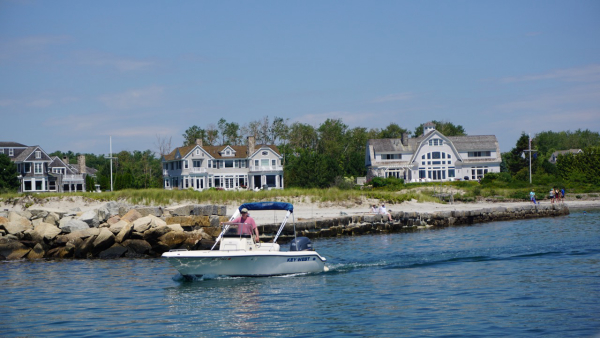Last Wednesday I “attended” a Zoom conference regarding the “3 T’s” of concern to virtually everyone in any business today: Trade, Tariff and Taxes. This time, it was the boating industry trying to figure out how to navigate what could best be described in nautical terms as choppy business waters.
As was pointed out repeatedly by the participants, boating is not one of the essential areas of life. Boats are most assuredly, discretionary purchases, despite the fact the prices can range from modest to stratospheric. Consequently, boat buying, as opposed to the recreational activity of boating, is a category where sales most definitely reflect the general mood of consumers.
The discussion was not a boring discussion of three-yacht families having to switch from imported to domestic wines. It was exactly the opposite. As representatives from the NMMA, NMMA/Canada and the EU repeatedly stated, they find themselves constantly having to remind legislators and regulators that “all boaters are not rich.”
Jeff Bezos and his really big boat get lots of media attention, but very little attention is given to the tens of thousands of family minivans towing well-worn aluminum fishing boats along for family vacations. They’re not only going to recreate in the boat, they’re planning on “batter and fry” rather than “catch and release” to lower the rising costs of family vacations.

There are millions more trailerable boats than super yachts. Many who work in the boating industry are like the “rest of us”: a blend of workers at big companies and owner/operators/employees of small “mom/pop” operations.
“Trade, tariffs and taxes — are dominating business leaders’ conversations across industries, and the marine sector is no exception,” said Soundings Trade Only Group vice president Michele J. Goldsmith, “As the global landscape continues to shift, it’s critical to understand how these changes may impact our industry and where opportunities for growth exist.”
The participants in the virtual conference were in agreement , but the Trump administration’s “frenetic” pace of change makes difficult jobs even more so. The Trump pace was described by one participant as a “ complete about-face from the ‘leisurely pace’ of Joe Biden”. As Molloy McDaniel of S-3 Group pointed out, “Trump has rewritten how things move in Washington.”
“Yes,” McDaniel pointed out, “executive orders have come at a furious pace, but he’s moved key legislation, like his Great Big Beautiful Bill along as well, despite razor-thin majorities in both sides of Congress.”
The pace of change, unfortunately, makes long-term planning more guesswork than any time before. As he pointed out, “updates come via Truth Social… every five minutes..that’s just the world we’re now in.”
Uncertainty notwithstanding, there have been some wins for manufacturers. The primary win, panelists agreed, was the “OBBB” passage, making key temporary tax cuts (R&D costs and capital expenditures for two) permanent.
Consumers, however, are still uncertain. Boats are products consumers don’t have to buy. So higher Interest rates and the potential of tariff-induced prices increases are keeping some purchasers, particularly buyers using credit, on the sidelines.
A slowdown in credit buying normally makes for more favorable buying conditions for cash purchasers. Cash purchasers, however, are also finding cash is more comforting than buying..especially when it comes to pure discretionary purchases.
Supply chain challenges were also cited as a major challenge for companies coping with the “Trump reality.” As Goldsmith pointed out, “figuring out supply chain issues and your suppliers is a whole lot like playing ‘Whack A Mole.’ As soon as you think you have things running smoothly, another challenge pops up.”
Viking Yacht Company’s John DePersenaire illustrated those challenges when sharing what Viking’s purchasing department was doing, and had done, to get a handle on supply chain and potential cost changes. “A very deep dive into our supply chain,” he said, “showed us that supply chain and costing were even more complicated than we’d imagined.”
“We are very conservative in our industry,” he said, “we can lose sight of just how complicated forecasting for mission-critical components can be. First, we itemized the country of origin for every part on our boats. Then, we itemized the components in that part and where the components came from. That drilling down allowed us to get an idea how much each part used in our boats could wind up costing..with and without tariffs.”
That exercise, he said, was done for all suppliers and any alternative sources. From that, Viking learned there would be increases in costs for some products simply because no domestic alternatives exist today.
Some forward thinking companies had laid in additional supplies of components and raw goods, DePersenaire said, but increases in lead times for consumers were likely, because those stockpiles will deplete in the next few months and “we’re looking at long lead times for American companies to come online.”
Boating is a global pastime, but it is a very global industry. That’s why the change to border policies is such a concern.
Manufacturing of components and complete boats has been predicated on the idea of “soft borders.” Today, it seems neither the borders nor the rhetoric regarding them, whether you’re talking US/Canada, US/Mexico or US/EU could be described as soft.
Does the US have an upper hand? Not really, but it’s easy, the panelists agreed, “to get distracted by all the political theatre.”
But as was pointed out, “business has to keep going.”
Even when where it’s going is still to be determined.
As always, we’ll keep you posted.
—Jim Shepherd